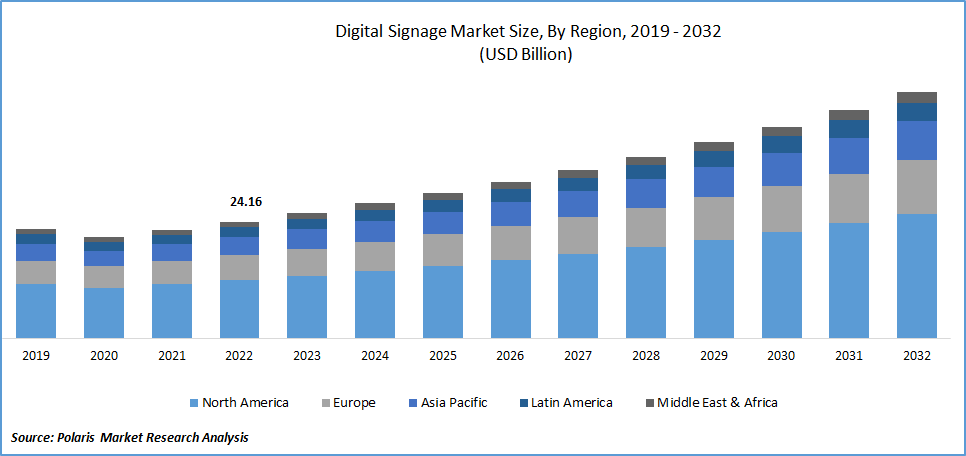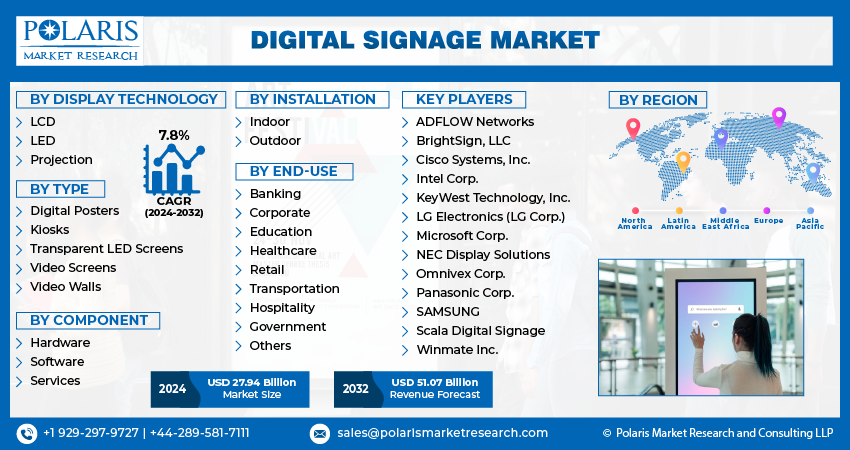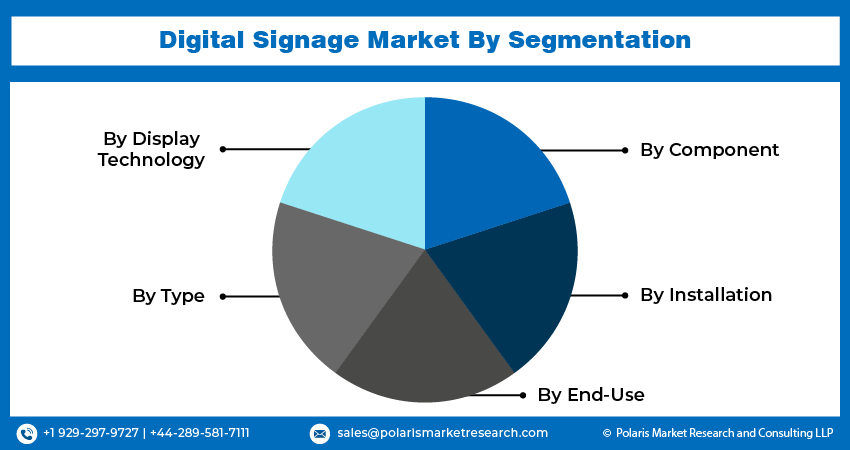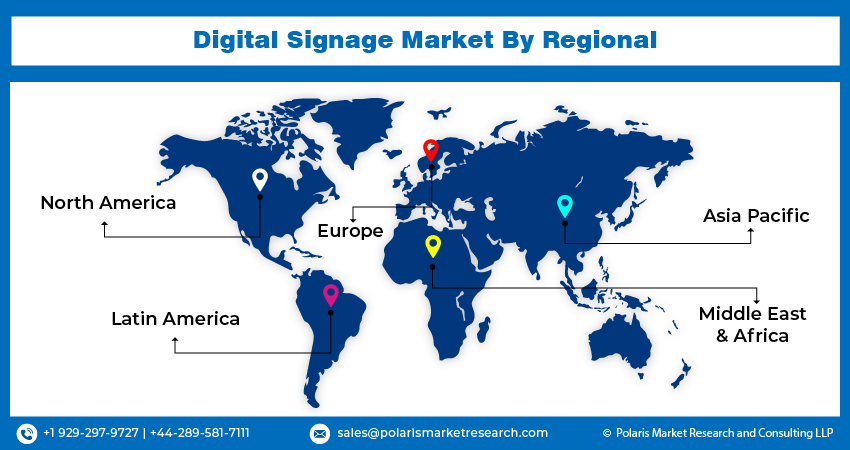
Digital Signage Market Share, Size, Trends, Industry Analysis Report, By Display Technology ( LCD, LED, Projection); By Type; By Component; By Installation; By End-Use; By Region; Segment Forecast, 2024 - 2032
- Published Date:Jan-2024
- Pages: 120
- Format: PDF
- Report ID: PM1038
- Base Year: 2023
- Historical Data: 2019-2022
Report Outlook
The global digital signage market was valued at USD 25.98 billion in 2023 and is expected to grow at a CAGR of 7.8% during the forecast period. There has been significant demand from various industry verticals for effective marketing, information sharing, or content sharing. Digital signages help industries showcase information more effectively by eliminating the need for printing information, thus saving huge costs incurred in printing and distribution. Digital signage is a part of the larger ecosystem of the signage market, and it can be called a combination of hardware and software, which can be used to display content at different places.

Know more about this report: Request for sample pages
Companies can reach out to potential customers and distribute their knowledge in multiple locations from a single source. This major advantage of digital signage is propelling its adoption, thus expanding its market.
Digital signage uses large screens for displaying information, thus enabling companies to be as creative as possible in showcasing their products and services. This helps them to target a large audience with creative publicity and promotions. For example, companies are using digital facades, a combination of LED lighting used on the exterior of buildings. These digital facades are controlled by software and can be used to create visuals and graphics on the front side of the buildings, thus giving a creative edge. These imaginative endeavors drive planners, specialists, and commercial organizations to increase their spending toward the computerized signage display. All these factors considered are, thus, anticipated to catalyze the overall business for the digital signage market.
The market research report offers an in-depth analysis of the industry to support informed decision-making. It offers a meticulous breakdown of various market niches and keeps readers updated on the latest industry developments. Along with tracking Digital Signage Market on the basis of SWOT and Porter’s Five Forces models, the research report includes graphs, tables, charts, and other pictorial representations to help readers understand the key insights and important data easily.
The COVID-19 pandemic has had a significant impact on the market. With the implementation of social distancing and other safety measures, businesses have had to rely on digital signage more than ever to communicate with customers and employees. As a result, there has been an increased demand for digital signage solutions that are flexible, reliable, and can be easily managed remotely. This has led to the development of cloud-based digital signage platforms that can be accessed and controlled remotely, allowing businesses to update their messaging in real-time. Moreover, with more people working from home, the demand for digital signage solutions that can be easily integrated with video conferencing and collaboration tools has also increased.

Industry Dynamics
Growth Drivers
Increased digital signage adoption in various industries, such as retail, healthcare, transportation, and hospitality, improves customer engagement and experience. Digital signage allows businesses to communicate effectively with their customers, promote their products and services, and create engaging experiences that can help increase brand loyalty and customer satisfaction.
In addition, the advances in display technologies. High-resolution, OLED, and LED displays have improved the quality and effectiveness of digital signage displays, making them more engaging and visually appealing. This has made it easier for businesses to create dynamic, eye-catching displays that capture customers' attention and increase engagement.
Furthermore, the increasing demand for cloud-based digital signage solutions drives market growth. Cloud-based solutions offer greater flexibility, scalability, and remote management capabilities, making it easier for businesses to manage and update their digital signage displays from anywhere at any time.
Report Segmentation
The market is primarily segmented based on display technology, type, component, installation, end-use, and region.
|
By Display Technology |
By Type |
By Component |
By Installation |
By End-Use |
By Region |
|
|
|
|
|
|
Know more about this report: Request for sample pages
Led Segment Dominated the Global Market in 2022
The LED segment has dominated the display signage market and will continue its dominance over the forecast period. LEDs have emerged as a standard product offering high-quality display. Manufacturers focus on creating flat, larger, brighter, and slimmer presentations using LED technology. The development of OLED displays has further advanced LED technology and is expected to drive its adoption in displays. However, the production costs, complex manufacturing process, and shorter lifespan of LED displays may pose challenges to the growth of this segment.
Although LCD technology has been widely adopted in advertising and marketing due to its ease of production and lower manufacturing costs, OLEDs offer superior picture quality, likely boosting demand.
Video Screens Segment Holds Highest Revenue Share of Market
The video screen segment contributed a high market revenue share in 2022 and is anticipated to dominate the market during the forecast period. The growth in this segment is due to its increased indoor and outdoor adoption. The video walls are used in auditoriums, retail stores, clubs, corporates, transport terminals, and sporting stadiums. The adoption of outdoor video walls has also been increased as they are all weatherproof, have a longer life, can be seen in any lighting conditions, and can be integrated as per the outdoor building size and shape.
Hardware Segment is Anticipated to Have Highest Market Share
The hardware segment is estimated to have the highest market share and is expected to keep its position over the coming years. Digital signage displays use hardware and software to control what needs to be displayed. Digital signage displays utilize hardware and software components to control the displayed content. The retail vertical is the largest adoption of this technology due to its demands for advanced advertising to promote items and services. The race among the retailers inferable from the assortment of item offerings in the business has prompted the developing awareness of viable display systems.
Accordingly, the retail segment uses digital signage greatly, as digitized promoting showcases an item, attracting many customers. The banking and financial sector is another noticeable adopter of this innovation. This is due to the broad presence of banks, ATMs, and online banking centers.
Outdoor Segment is Expected to Hold Significant Market Share
The outdoor segment in signage displays is expected to hold a significant market share. Increase in demand for outdoor digital signage displays, which is likely to contribute significantly to the growth of the digital signage industry. This growth can be attributed to the expanding transportation vertical in developing regions and rising interest from advertisers to display their advertisements on buildings, outside malls, open auditoriums, and events such as sports or concerts. These factors are expected to drive the market for outdoor digital signage displays in the coming years.

North America is Expected to Hold the Largest Market Share
North America is anticipated to have the largest market share for digital signage. This growth can be attributed to the high adoption rate of digital signage solutions in various sectors, such as retail, healthcare, transportation, and hospitality. The region has a high level of technological advancements, and the increasing demand for interactive displays and the growing need for digital advertising are expected to drive the market growth further.
Besides, increasing government activities to introduce computerized signage in workplaces to maintain a consistent data stream is again anticipated to provide traction to the market growth.

Competitive Insight
Some of the major players operating in the global market include, ADFLOW Networks, BrightSign, LLC, Cisco Systems, Inc., Intel Corp., KeyWest Technology, Inc., LG Electronics (LG Corp.), Microsoft Corp., NEC Display Solutions, Omnivex Corp., Panasonic Corp., SAMSUNG, Scala Digital Signage, and Winmate Inc.
Recent Developments
- March 2022: Planar has launched the Planar Luminate Pro Series and Planar Venue Pro Series, two new LED video wall displays families. These displays are specifically designed to cater to the needs of fast-paced events and high-ambient light environments.
- April 2022: Control Point Technology, an AV integrator, partnered with Daktronics to equip nine existing and upcoming Barstool Sportsbook branded locations with LED video and ticker displays.
- February 2023: Cisco announced that it will serve as Technology Partner of St. Louis CITY SC, leveraging its Wi-Fi, security, networking and digital signage solutions. According to Cisco, the partnership aims to develop a highly connected and fan-centric environment in Major League Soccer.
- February 2023: Winmate Inc., a global leader in industrial solutions with extensive experience creating and delivering high-quality industrial displays monitors, announced the release of its outdoor display series. According to Winmate, the new displays will bring higher visibility to window displays, shelter advertising, and smart cities.
Digital Signage Market Report Scope
|
Report Attributes |
Details |
|
Market size value in 2024 |
USD 27.94 billion |
|
Revenue forecast in 2032 |
USD 51.07 billion |
|
CAGR |
7.8% from 2024 – 2032 |
|
Base year |
2023 |
|
Historical data |
2019 – 2022 |
|
Forecast period |
2024 – 2032 |
|
Quantitative units |
Revenue in USD billion and CAGR from 2024 to 2032 |
|
Segments Covered |
By Display Technology, By Type, By Component, By Installation, By End-Use, By Region |
|
Regional scope |
North America, Europe, Asia Pacific, Latin America, Middle East & Africa |
|
Key Companies |
ADFLOW Networks, BrightSign, LLC, Cisco Systems, Inc., Intel Corp., KeyWest Technology, Inc., LG Electronics (LG Corp.), Microsoft Corp., NEC Display Solutions, Omnivex Corp., Panasonic Corp., SAMSUNG, Scala Digital Signage, and Winmate Inc. |
We strive to offer our clients the finest in market research with the most reliable and accurate research findings. We use industry-standard methodologies to offer a comprehensive and authentic analysis of the Digital Signage Market. Besides, we have stringent data-quality checks in place to enable data-driven decision-making for you.
Browse Our Top Selling Reports
Corticosteroids Market Size, Share 2024 Research Report
Carboprost Tromethamine Market Size, Share 2024 Research Report
Cytomegalovirus Treatment Market Size, Share 2024 Research Report
Soybean Market Size, Share 2024 Research Report
Property And Casualty Insurance Market Size, Share 2024 Research Report
FAQ's
The global digital signage market size is expected to reach USD 51.07 billion by 2032
Key players in the market are ADFLOW Networks, BrightSign, LLC, Cisco Systems, Inc., Intel Corp., KeyWest Technology, Inc., LG Electronics (LG Corp.)
North America contribute notably towards the global digital signage market
The global digital signage market The global digital signage market
The Digital Signage Market report covering key segments are display technology, type, component, installation, end-use, and region.
